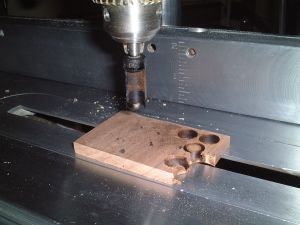






Part Three: Final Assembly

This is a Wagner Safe-T-Plane. It is a great way to flatten a board. The large spinning disk has cutters that shear off the wood. The Shopsmith’s large table and adjustable fence make it the ideal partner for the Safe-T-Plane. I begin with the “good” side of the board facing down (it’s the flattest) and I plane the side that won’t show. Once that side is flat, I flip the board over and clean up the “good” side.

This is a close up of the Safe-T-Plane.

I’m using this plug cutter to make decorative walnut plugs. Don’t drill all the way through—sand or cut the plugs free when you’re done drilling.

The Shopsmith is the perfect tool for drilling the pilot holes and counterbores for the top. I use the fence and a simple pencil line to keep the holes even.

Liberal amounts of Elmer’s glue and the walnut plugs fill the holes. After the glue dries the plugs will be trimmed off and sanded smooth.

It’s absolutely square and stable, just like I knew it would be. A little sanding, and this project will be ready for the finishing room.
The Bottom Line
No woodworking tool is as versatile or as misunderstood the Shopsmith. It can do just about anything, and the longer you work with your Mark V the more you discover what it can do. The trick is to think like a Shopsmith owner.
Norm Abram, my woodworking hero, didn’t get it. He had a Shopsmith for a short while, but never put it to good use, and eventually got rid of it. Too bad, because I’ve seen him build many a jig or fixture trying to force his other machines to do tasks that could be easily accomplished with a Shopsmith.
![]()